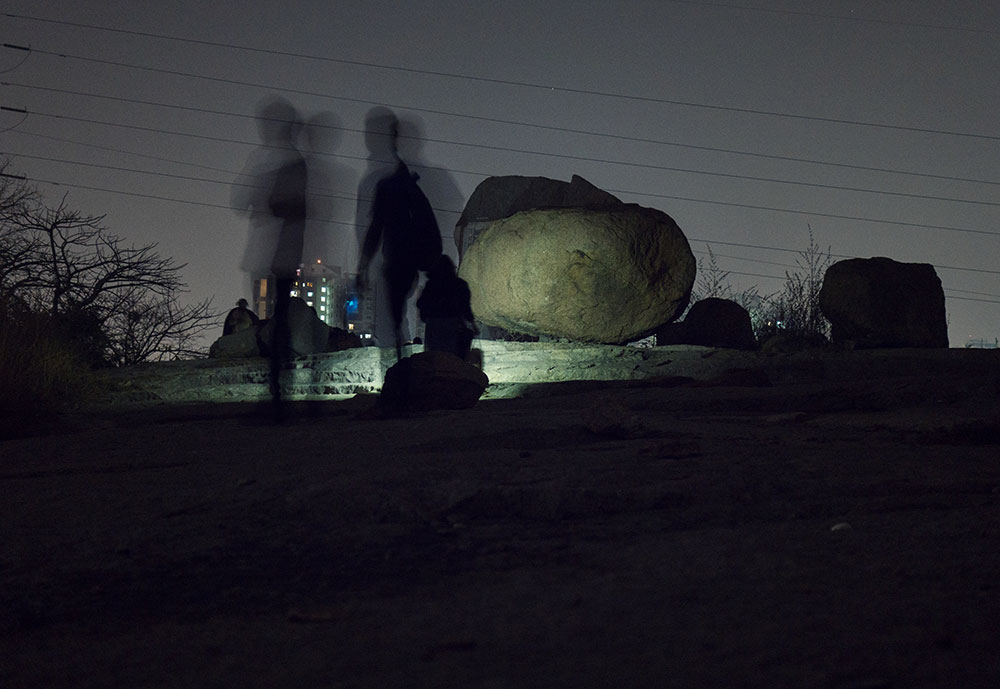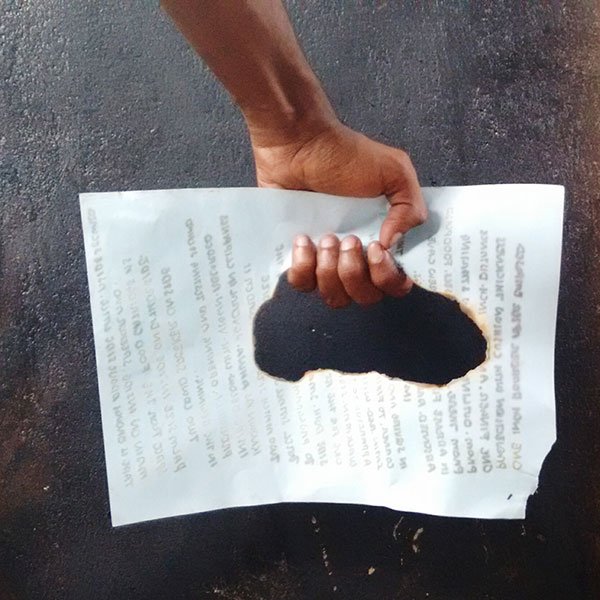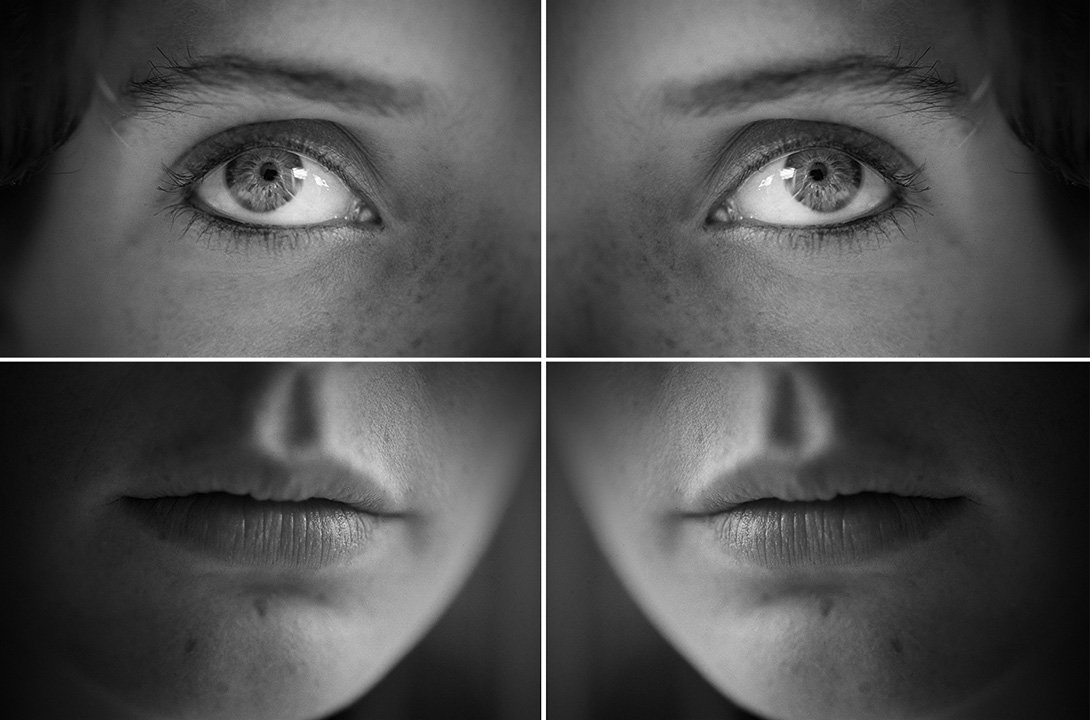Panorama
Photography and Beyond
Photo Mail presents
A panoramic view of
The art of photography’s
Interaction and
Interrelation with other
Art mediums such as literature
Architecture, and
Other visual media
Joyel K Pious
Reads
The four-channel video
Installation ‘Fragmented Identities’
By Andreas Ullrich
Displayed between
December 15 and 17, 2022,
At
Forplay Society, Kochi
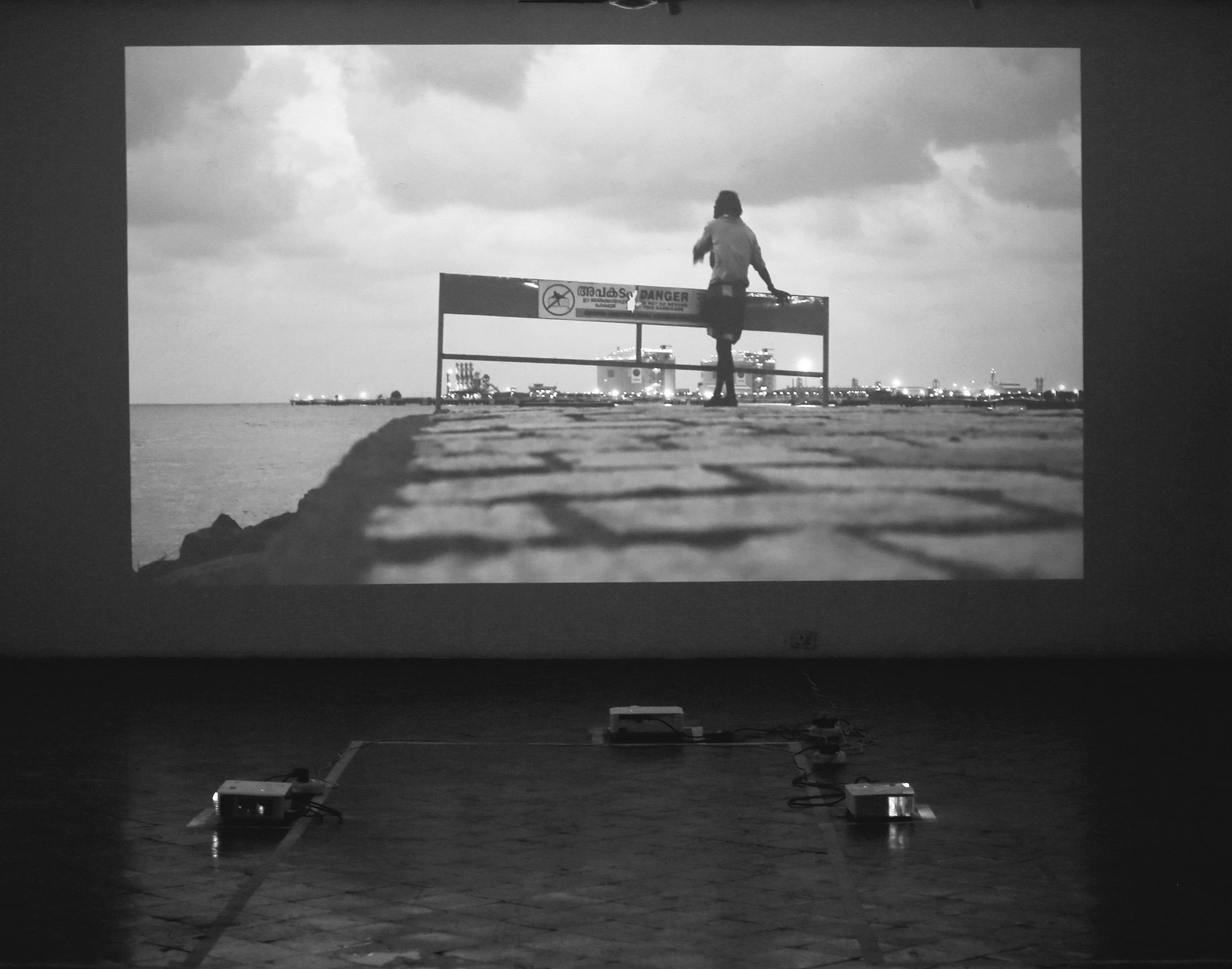
Fragmented Identities Video Installation by Andreas Ullrich
A north wind was gusting across the sky on that winter afternoon. The sun rested behind the thick white clouds carpeting the horizon. I sat watching small waves appearing and disappearing on the pale green surface of the mighty river. On that sparsely crowded shore, a man, probably in his sixties, stood facing the flow. His uncombed hair fluttered in the air and his soiled cotton clothes struggled to stick to his fragile body. The man was speaking a language unknown to me. His gestures signalled he was talking to the water and the sky. Time probably didn’t exist around him, for he was still immersed in the act when I left the shore after an hour. While this stranger conversed with the elements, I was having a silent chat with myself. I wondered if there existed a black-and-white line dividing the two of us as ‘normal’ and ‘abnormal’. Even if such a line was to be drawn, did anyone really qualify to do it?
I happened to recall the stranger on the shore recently while talking to the German-born artist Andreas Ullrich. Titled ‘Fragmented Identities’, his four-channel video installation projected separate black and white footage – recorded in Kochi, Frankfurt and Athens – of four men having conversations with their surroundings. The fact that a camera watched and recorded the private yet public acts of these men was the focus of my conversation with Andreas. The free-wheeling chat, which lasted for almost two hours, took us on a ride through the realms of sanity, society, time, freedom and surveillance. Engrossed in the dialogue we sat in the middle of a closed room, the cracked walls of which acted as screens.
An influx of thoughts engulfed me as I saw the four men immersing themselves in their own world. I felt a sense of freedom in their acts. Time seemed to be staying still, like a frozen river, around them. I questioned myself for the sudden urge to push these men beyond the imaginary line separating the sane from the insane. To resist the impulse to compartmentalize people, I needed to start from the basics i.e., see them individually. The men in the video installation belonged from diverse backgrounds. One of them had the job of inviting customers to a restaurant, but the street where he sat was not a crowded one. Time literally slept in front of him. The only way to cope with such colossal boredom would be some sort of indulgence. He just needed to stop caring about the surroundings, and infinite freedom would lay itself bare in the front. Similarly, each of the other three individuals in the footage was engaging with their environment, and all of them seemed to be absorbed in their acts. Who am I to judge their freedom? Ironically, getting lost in nature and being unmindful of the opinions of others are goals often sought by the high priests of philosophy and spirituality. I remembered Buddha and Christ, the two legends who preached renunciation and wanderings. Weren’t they breaking the codes of sanity defined by their societies? Don’t many of us dream about the freedom they achieved?
The capacity to draw bigger pictures from minuscule details is a blessing that helps us make sense of the world. It is an essential raw material in science, art, philosophy, poetry, economics and architecture. Like a double-edged sword, this boon keeps a curse in its company. Assisted by it, we build compartments and walls to separate people into races, classes, castes, communities and nations. In this sense, the monologues of the four men in ‘Fragmented Identities’ would be normally labelled ‘abnormal’. Without borrowing from Nietzsche, this idea would be less poetic. “In individuals, insanity is rare; but in groups, parties, nations and epochs, it is the rule.” That sanity is a reward from society for acting constantly, is a lesson most of us learn during our time here. And a good performance means forgetting that there is any acting happening at all. A bad performer most of the time, I am instantly aware of it whenever I act. Ever wary of the prying eyes of society, I am forced to act many a time — to be judged as normal — which makes me uncomfortable at the same time. Aren’t those men in ‘Fragmented Identities’ and the stranger I encountered on the riverbank, good performers? Unlike professional actors, these men neither had a fixed stage nor did they care about the spectators. Besides acting to suit the occasion every now and then, almost all of us consume performances in the form of entertainment. Be it in movie halls, theatres, opera houses, cafes or galleries, we pay and entertain ourselves to the best of performances. Yet, we don’t trust our impulses to make any sort of gestures or actions, which would attract immediate attention, in public. Conversely, we force ourselves to act and appear good whenever someone is watching us or turning a camera towards our faces.
Despite camera becoming an inseparable part of daily life, many of us still feel awkward when asked to pose for a picture. As we struggle to look normal in front of the camera, the picture looks increasingly abnormal. The men in ‘Fragmented Identities’ seem to say that we just need to forget that watchful eyes surround us. Andreas told me that he considered the four men in his artwork as performers who would normally be denied such a title. But, how would we know for sure? Did he have consent from them ahead of recording their acts? Instead of solely relying on the artist’s words, I decided to examine the footage itself for some answers. The gaze of a photographer can speak a lot about his/her relationship with the subject. Andreas places the camera on the ground or on a level lower than that of the subjects. Devoid of any movement, it watches the men as they go on with their acts. I would normally feel annoyed or interrupted by a camera watching me, but the men here seem to be interacting with it in a rather playful mood. They give little notice to the camera most of the time. But when the performers decide to mind the camera, they all react differently. Friendliness, curiosity, elation, annoyance and resignation reflect on their face alternately. Andreas told me that he kept the camera at the lowest possible angle to reassure his subjects that neither he nor his camera posed any threat. However, does that mean the men gave consent to record them?
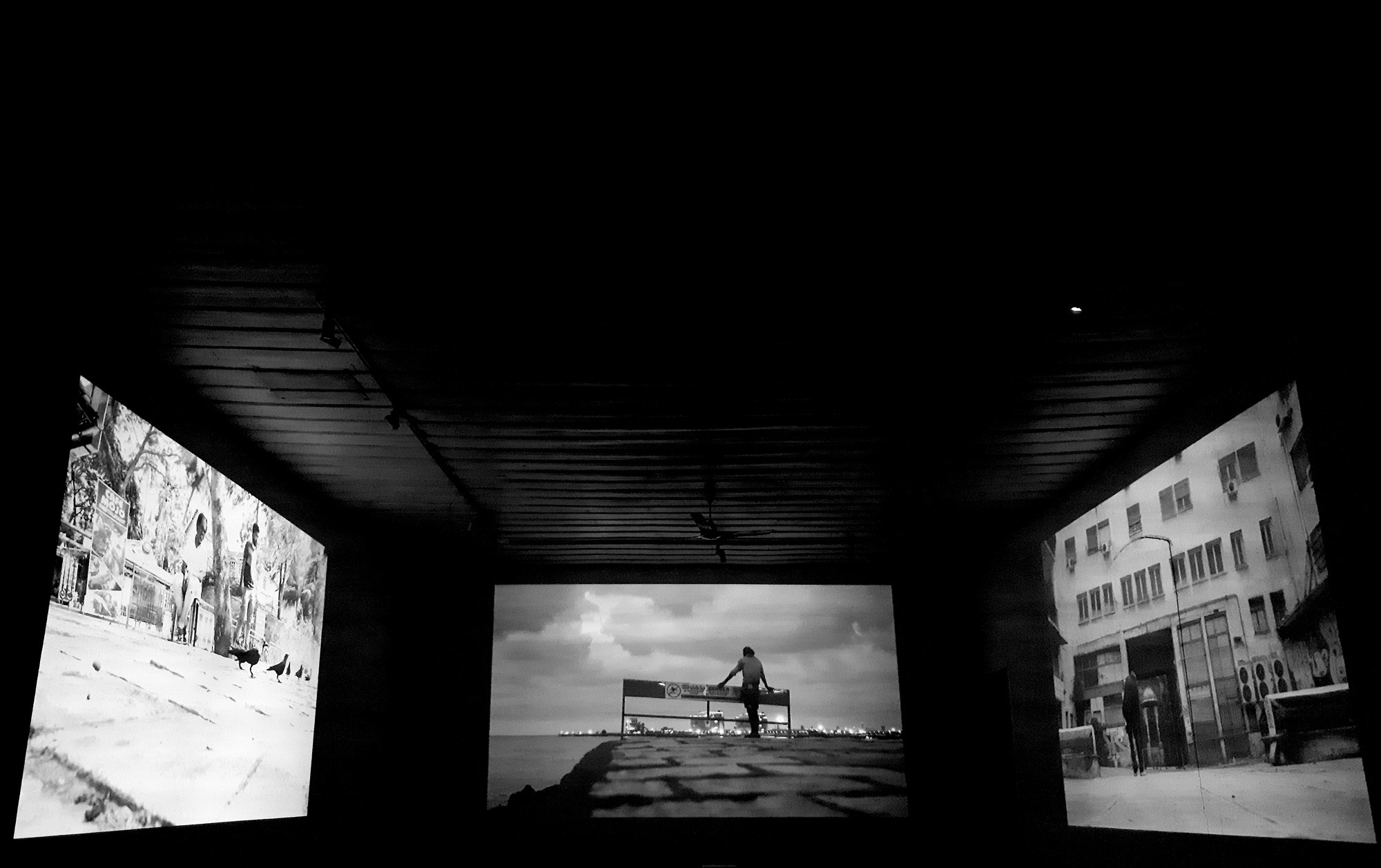
Fragmented Identities Video Installation by Andreas Ullrich
The idea of consent in photography is a tightly contested terrain. During its almost 200 years of existence, the medium of photography generally denied its subjects any rights regarding consent. Photographers define the concept in their own myriad ways and there is no universally accepted formula for defining it. While most contemporary photography practitioners claim that they seek consent before shooting their human subjects, there are many who claim that such prior notice will take away spontaneity and drama from the images. There is also the question of consent to propagate the images. Does the permission to photograph a person give the photographer all the rights to propagate that image in an unlimited number? Doesn’t the photographer need consent from the subject whenever that photograph is exhibited? Doesn’t the subject deserve a portion of the royalty a photographer receives from the image? The answers to these questions are as diverse as the range of cameras available in the market. The technological developments in recent decades and the explosion of digital photography have opened a floodgate of issues related to consent. Academicians working in this field say that consent shouldn’t be just one conversation and the subjects should be fully informed about the scope of the work and where their faces would appear [1]. However, there is a consensus among many practitioners that the question of informed consent doesn’t hold while shooting in a public space where privacy is not expected. These ideas of informed consent and public space present themselves in a more complex manner in ‘Fragmented Identities’, which, according to its creator, has received its share of criticism. Who will speak on behalf of the subjects who may not be in a position to speak for themselves? Do the public spaces where the men of ‘Fragmented Identities’ were videographed, constitute a private space as well? As the primary responsibility of defending the creation rests with the artist, I listened to Andreas explaining his intentions behind the artwork.
For a society which instantly demarcates its own members based on certain parameters, the subjects of Andreas are outcasts and vulnerable at the same time. Their public actions would be judged trivial and non-consequential, and their existence less important than ours. We normally keep ourselves at a ‘safe distance’ from them or push them away from our comfort zones. Did the art violate anything compared to the violations already committed by us? Isn’t the artist, through his subjects, mocking us for being poor actors and judges? Andreas told me he considered the men of ‘Fragmented Identities’ better performers than any of us who keep on acting to stay sane in the eyes of society. By displaying the work in a closed room and not drawing any monetary benefit from it, Andreas said, he wanted to question the hypocrisy of the society which acts all the time but pays for staged performances.
There are situations where photographers, especially photojournalists, face the ethical dilemma of photographing the victims of mental illness. As the question of informed consent becomes extremely fluid in such situations, it is the photographer’s responsibility to make sure that his/her intentions are directed towards the well-being of his subjects. Joao Silva, a New York Times staff photographer who has photographed many people with mental illness, says that we have to be acutely aware that the photographed subjects are humans. “…It’s precisely because they are human that makes it particularly important to show the situations they are in. If not the camera, who then?” [2] Having said that, the men in ‘Fragmented Identities’ may not be mentally ill or abnormal as assumed by the spectators. It could be that our prejudices just imprisoned them in the cell of insanity. This very idea of the prejudices of spectators has a key role in visual culture. It hinges on the question of whether our preconceived notions are strengthened by the portrayal of people and incidents in certain ways. The American philosopher and political activist Susan Sontag, who microscopically dissected photographic images throughout her life, had called to attention the objectifying nature of spectatorship. “Something becomes real by being photographed,” she said, adding that it becomes real to those who are elsewhere and following it as mere news. How would the spectators negotiate with the footage created by Andreas? Doesn’t this artwork ask us more questions than the answers we seek from it?
I remember taking a cab ride once through an almost empty highway at night. To kill boredom, I kept my eyes hooked on the speedometer. The cab was racing past wayside trees and lamp posts at a speed close to 120 km/hr. The driver seemed to be engrossed in the madness of speed. Stray dogs trying to cross the road stepped back in fear. The road ahead looked like a sleek straight line. In the rush of adrenaline, I wished the speedometer clock a higher score. All of a sudden, the driver began to kill speed. I threw a curious glance at him as the car ran at a sluggish 40 km/hr. The driver didn’t utter a word but pointed his finger straight up. I saw a bunch of small red lights blinking on a pole ahead; a camera to catch speeding. As we crossed the surveilling eyes, the speedometer started rising again. A small act of the driver to stay in the good books, and a completely normal one indeed.
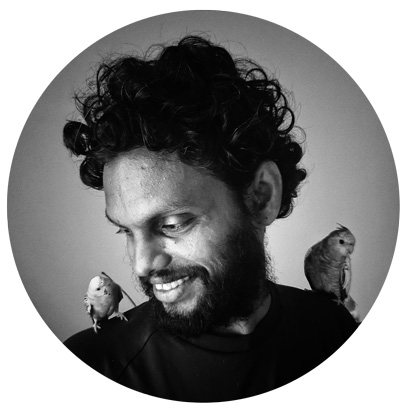
Joyel K Pious is a bilingual editor and photographer from Thrissur district of Kerala. He is interested in the interwoven relationship of humans among themselves and with nature. He also extends his services as News Editor, PhotoMail.
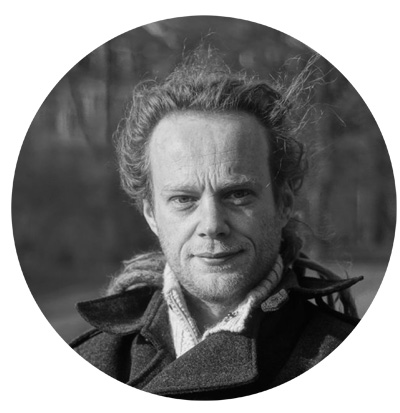
Andreas Ullrich is a photographer-turned-media artist from Germany. After completing his law education in 1998, Andreas turned to studying photography academically. Later, he switched to media art, focussing on the potential of mixing various modes of expression. A recipient of several awards and scholarships, Andreas won the Youth Photography Award of the German Society for Photography in 1998. He is a co-founder and curator of independent art space ‘C.Rockefeller Center for the Contemporary Arts’, Dresden, Germany.
Andreas Ullrich started recording footage for Fragmented Identities during the early period of Covid lockdown in India. His reflections on the ideas of identity being torn apart during the crisis are the basis for this creation.
Published on January 19, 2023
Share
Related Articles
A Sense of Dislocation
Indian photography hasn’t seen many such explorations that interact and intersect with other media such as light art. But this has started to change in the last couple of years, with a few photographers trying to do light painting; and it is in this context that Joyel K Pious and Gaurav Rachamalla’s collaborative photo project becomes striking. Although this style is popular in the west, this collaborative project stands tall and distinctive amidst the usual Indian street and documentary photographs. It probes the philosophical underpinnings that are intrinsic to the medium itself as well as pose several questions related to urbanisation.
On Ajith Nedumangad’s Photographs
It is the sheer absurdity of the sculptures created and photographed by Ajith that hits the viewer right from the off – juxtapositions (reminiscent of the Dadaists and Surrealists) in which materials and the forms they are used to create are often in conflict with each other and, at other times, are self-referential in a darkly humorous manner.
On Photography, Remembering Susan Sontag
On Susan Sontag, a poem by famous Malayalam-English poet N Ravi Shankar


